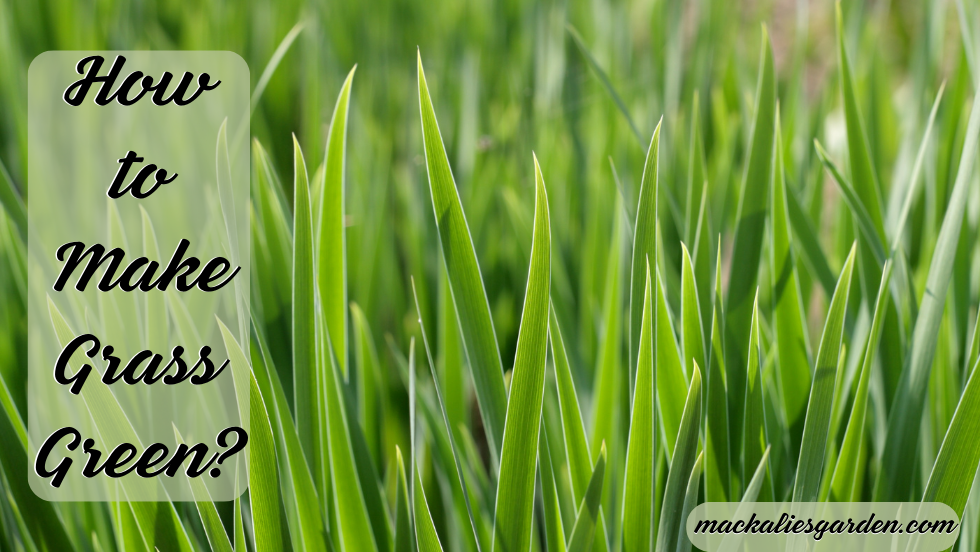Many homeowners dream of a lush, green lawn, but achieving that perfect shade of green can be challenging. The key to unlocking the verdant beauty of your grass lies in understanding and properly managing several factors, including using the right lawn seed, optimal light exposure, and appropriate lawn care practices.
If you want to know what makes grass green? Read this article to find out the secret behind the vibrant hue.
How to Make Grass Green? | What Chemical & Fertilizer to Use
At the heart of this natural wonder is the chemical that makes grass green: chlorophyll. It is a pigment produced by chloroplast cells as grass grows. This chemical absorbs light in red and blue wavelengths and reflects green light to our eyes. The chloroplasts cells that hold and produce chlorophyll molecules only function when the right amount of light is present. When the turf is in darkness, the lawn turns white and dies due to a lack of chlorophyll production.
With this knowledge in mind, let’s explore the steps necessary to make your grass green and thriving:
Choose the Right Lawn Seed
Select a grass seed well-suited to your region’s climate and soil conditions. Different grass varieties have specific light, water, and nutrient requirements, so choose the best match for your yard’s environment.
Make Sure Your Yard Gets Enough Sun
Grass needs sunlight to produce chlorophyll. Monitor your lawn to ensure that it receives adequate sun exposure. Remove or trim any branches, bushes, or structures that might block sunlight from reaching your grass.
Add Iron Supplements
What fertilizer makes grass dark green? The answer is Iron. It is essential for chlorophyll production. If your grass looks lackluster and yellowish, it may need an iron boost.
Iron treatments work great on all grass types, but Bluegrass and Fescue thrive with additional iron applications.
Use iron supplements or iron-rich fertilizers to enhance chlorophyll production and give your grass a vibrant green hue. If you want to know when to apply it, visit the post: When to Apply Iron to Your Lawn?
Water Wisely
Proper watering is crucial for a healthy, green lawn. Overwatering can lead to shallow root growth and increased vulnerability to pests while underwatering can reduce chlorophyll production. Ensure your grass receives about an inch of water weekly through rainfall or supplemental watering.
Types of Soil Matter For Watering
Different types of soil will absorb water differently.
For Sandy Soil Grass Watering
Sandy soil can soak up water quickly, yet it drains away rapidly. If your lawn has sandy soil, you should plan on watering more often and gradually enrich the surface by top-dressing with compost every other year. Doing this will help improve the quality of your soil over time.
For Sandy Loam, Grass Watering
The best way to water grass growing in sandy loam soil is to apply deep, infrequent watering. This will allow the water to penetrate deeper into the root zone and create healthier, more resilient roots.
For Clay Grass Watering
Clay soils take longer than other types of soil to absorb water fully. As such, they require more thorough and frequent watering sessions. Water your grass deeply, but less often during the cooler months, and water more frequently in summer when temperatures rise.
Use the Right Fertilizer
Before fertilizing your lawn, I suggest you take a soil test to determine the nutrient content of your soil. This will help you decide which type of fertilizer to use and how often it should be applied. General-purpose fertilizers are an excellent choice for lawns that need a boost, while slow-release nitrogen fertilizers can benefit grass that needs extra nutrients.
Fertilizers rich in nitrogen can help boost chlorophyll production, leading to a greener lawn. Make sure to choose a high-quality, slow-release fertilizer to give your grass the nutrients it needs to thrive and avoid over-fertilization, which can harm your lawn.
Mow Properly
Mowing your lawn at the correct height encourages more profound root growth and enhances chlorophyll production. Different grass types require different mowing heights, so research your lawn’s ideal size. And always keep your mower blade sharp, as dull blades can damage your grass.
Choose Professional Lawn Maintenance Services
If all else fails, or you prefer a hands-off approach, consider hiring a professional lawn maintenance service. They can help you achieve a healthy, green lawn by providing specialized care that suits the unique needs of your yard.
Conclusion
In conclusion, how to make grass green is an art and a science. By adequately managing light exposure, providing the right fertilizer, and incorporating appropriate lawn care practices, you can discover the secret behind the vibrant hue and achieve a beautiful, lush lawn. With these tips, your grass will grow green before you know it!
I hope this article helps you make your lawn healthy and green. If there’s anything else we can help with, don’t hesitate to reach out.

Douglas Mackalie is a Founder of Mackalies Garden. He is one of the most exciting people you’ll ever meet. He has 25 years of experience in horticulture and gardening, most of which he’s spent outdoors getting his hands dirty.

